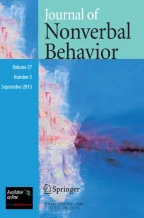Abstract
People's beliefs about the association of 19 visual and auditory cues with deception were assessed in one of two questionnaires: Subjects were asked to indicate the association of each cue with deception in their own behavior (self-perception condition) or in other people's behavior (other-perception condition). The 19 behaviors listed in the questionnaires had been previously examined in research on actual behaviors associated with deception; ten of these behaviors had also been examined in research on cues associated with judgment of deception. Stronger association between the various cues and deception were obtained in the other-perception than in the self-perception condition, indicating that people believe they control their own deceptive behavior better than other people control theirs. Beliefs about the association of each behavior with deception (averaged across the two conditions and sex of respondents) correlated .11 with the actual association of each cue with deception, and .44 with the association of each cue with judgment of deception. The possibility that the correspondence between beliefs about deception and actual cues to deception is higher for some specific types of lie-telling was discussed.
Similar content being viewed by others
References Notes
DePaulo, B.M., Rosenthal, R., Rosenkrantz, J., & Green, C.R. Actual and perceived cues to deception. Manuscript submitted for view, University of Virginia, 1981.
Krauss, R.M., Geller, V., & Olson, C. Modalities and cues in the detection of deception. Paper presented at the meeting of the American Psychological Association, Washington, D.C., September, 1976.
References
Cohen, J.Statistical power analysis for the behavioral science. (Rev. ed.). New York: Academic Press, 1977.
DePaulo, B.M., Lassiter, G.D., & Stone, J.I. Attentional determinants of success at detecting deception.Personality and Social Psychology Bulletin, in press.
Hemsley, G.D., & Doob, A.N. The effect of looking behaviors on perceptions of a communicator's credibility.Journal of Applied Social Psychology, 1978, 8, 136–44
Kraut, R. Humans as lie detectors.Journal of Communication, 1980,30, 209–216.
Rosenthal, R. Combining results of independent studies.Psychological Bulletin, 1978,85, 185–193.
Zuckerman, M., DePaulo, B.M., & Rosenthal, R. The verbal and nonverbal communication of deception. In L. Berkowtiz (Ed.),Advances in experimental social psychology. Vol. 14, New York: Academic Press, in press.
Author information
Authors and Affiliations
Rights and permissions
About this article
Cite this article
Zuckerman, M., Koestner, R. & Driver, R. Beliefs about cues associated with deception. J Nonverbal Behav 6, 105–114 (1981). https://doi.org/10.1007/BF00987286
Issue Date:
DOI: https://doi.org/10.1007/BF00987286
